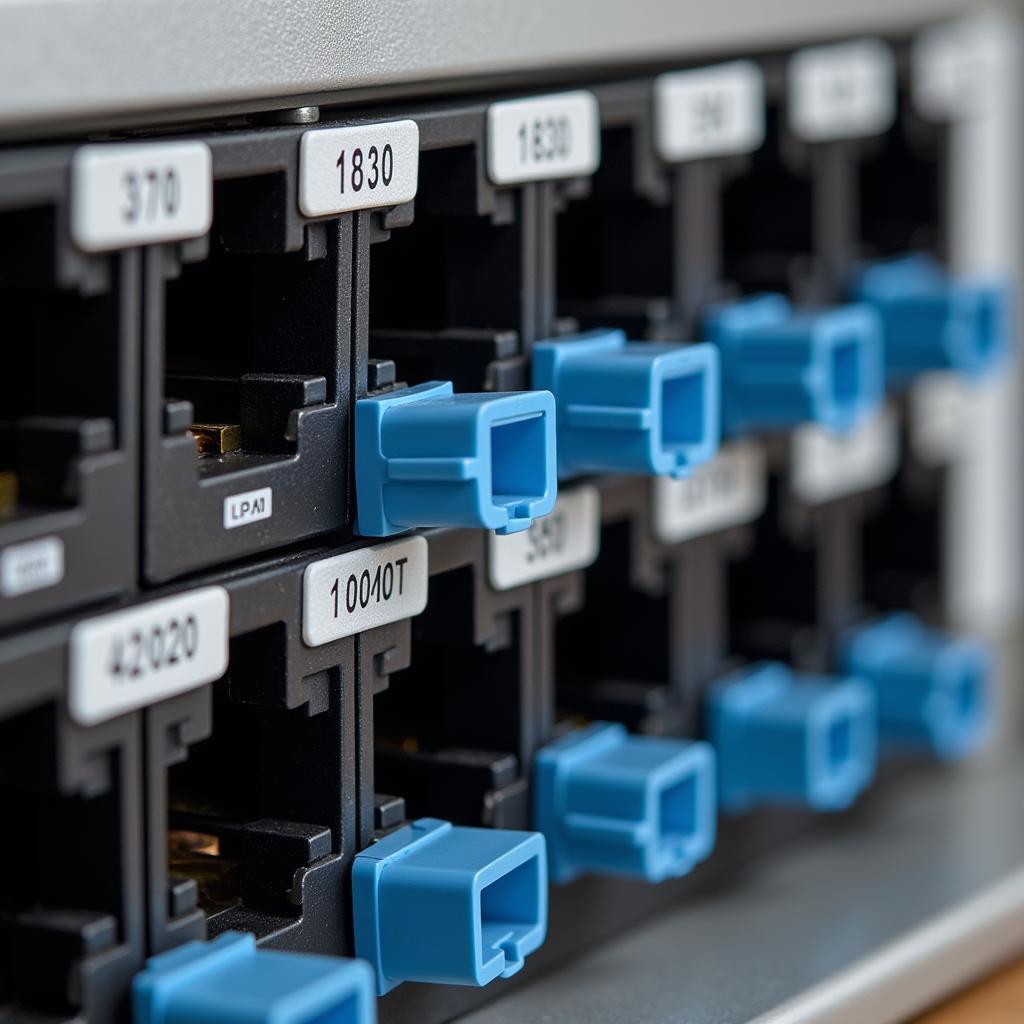Patch Frames are an often-overlooked but crucial component of any structured cabling system. They provide a centralized point for connecting and managing network cables, making your network neater, more organized, and easier to troubleshoot. But what exactly is a patch frame, and why is it so important for your network infrastructure?
 Close-up view of a patch panel
Close-up view of a patch panel
What is a Patch Frame?
A patch frame, also known as a patch panel, is a passive network device that houses a series of ports, typically RJ-45 jacks, used to terminate network cables. Think of it as a switchboard for your network, where each port corresponds to a specific network connection point. Instead of directly connecting devices to wall outlets, you connect them to the patch frame using short, flexible cables called patch cords.
Why Use a Patch Frame?
Using a patch frame offers numerous benefits, making it an indispensable part of a well-designed network:
- Improved Organization: Patch frames eliminate the tangle of cables that often plagues networks, providing a clean and organized central point for all connections.
- Simplified Troubleshooting: When issues arise, tracing cables back to their source is significantly easier with a patch frame, allowing for quicker problem identification and resolution.
- Enhanced Flexibility: Adding, removing, or changing network connections becomes a breeze with a patch frame. Simply swap out patch cords instead of rewiring entire segments.
- Increased Scalability: As your network grows, a patch frame makes it simple to accommodate new devices and connections without major disruptions.
How Does a Patch Frame Work?
A patch frame functions as a bridge between your network devices and the structured cabling infrastructure. Here’s a breakdown of the process:
- Cable Termination: Network cables from wall outlets or other connection points are terminated at the rear of the patch frame using specific wiring standards like T568A or T568B.
- Port Connection: Each terminated cable connects to a designated port on the front of the patch frame, typically an RJ-45 jack.
- Patch Cord Usage: Short patch cords connect the front ports of the patch frame to your network devices, such as computers, servers, or switches.
This setup creates a clear separation between the fixed cabling infrastructure and the active network connections, providing flexibility and ease of management.
Types of Patch Frames
Patch frames come in various configurations to suit different network needs:
- RJ-45 Patch Frames: The most common type, utilizing the standard RJ-45 connector for Ethernet connections.
- Fiber Optic Patch Frames: Designed for fiber optic cables, offering higher bandwidth and longer transmission distances.
- Voice Patch Frames: Used for telephone systems, providing a centralized point for managing phone lines.
The choice of patch frame depends on the type of network cables and the specific requirements of your setup.
 Network technician connecting cables to a patch panel
Network technician connecting cables to a patch panel
Choosing the Right Patch Frame
Selecting the appropriate patch frame involves considering several factors:
- Port Density: Determine the number of ports required based on your current and future network needs.
- Cable Type: Choose a patch frame compatible with the type of network cables used in your infrastructure.
- Rack Mountability: Ensure the patch frame fits your server rack or wall-mounting space.
- Labeling Options: Opt for a patch frame with clear and easily identifiable labeling options for simplified management.
Maintaining Your Patch Frame
Proper maintenance ensures optimal performance and longevity of your patch frame:
- Regular Cleaning: Dust and debris can accumulate on the patch frame and affect connectivity. Use compressed air or a soft cloth for cleaning.
- Cable Management: Keep patch cords organized and labeled to prevent tangling and facilitate troubleshooting.
- Visual Inspection: Periodically inspect the patch frame for loose connections, damaged ports, or other signs of wear and tear.
By incorporating a patch frame into your network and following these maintenance tips, you’ll enjoy a more organized, reliable, and scalable network infrastructure for years to come.
FAQs about Patch Frames
1. What is the difference between a patch frame and a switch?
While both handle network connections, a patch frame is a passive device that simply connects cables. A switch, on the other hand, is an active device that manages data flow between connected devices.
2. Can I install a patch frame myself?
While possible for experienced individuals, it’s recommended to consult a qualified network technician for installation to ensure proper grounding, cable termination, and adherence to wiring standards.
3. How often should I clean my patch frame?
Cleaning frequency depends on the environment. In general, cleaning every three to six months is advisable, or more frequently in dusty or high-traffic areas.
4. What are some common problems with patch frames?
Loose connections, damaged ports, and improper cable termination are some common issues. Regularly inspecting and maintaining your patch frame can help prevent these problems.
5. Can I use a patch frame for both data and voice connections?
While possible to use a single patch frame for both, it’s recommended to use separate patch frames for data and voice to avoid potential interference and simplify troubleshooting.
Need further assistance with your network setup?
Contact our team of experts at Phone Number: 0902476650, Email: [email protected], or visit our office at 139 Đ. Võ Văn Kiệt, Hoà Long, Bà Rịa, Bà Rịa – Vũng Tàu, Vietnam. We offer 24/7 customer support to answer all your networking queries.
Explore our website for more insightful articles and resources to help you build a robust and efficient network infrastructure.





